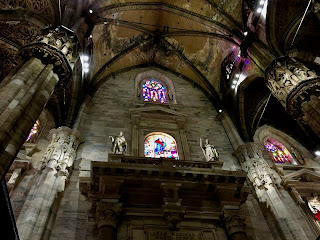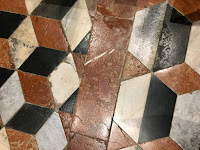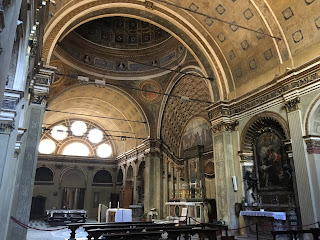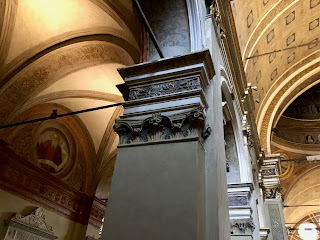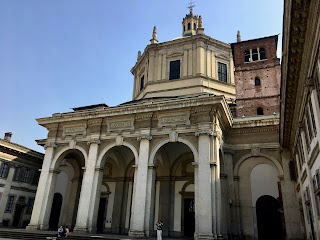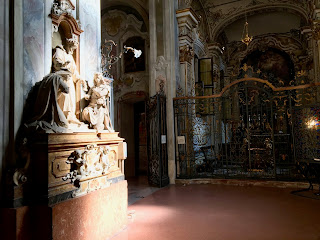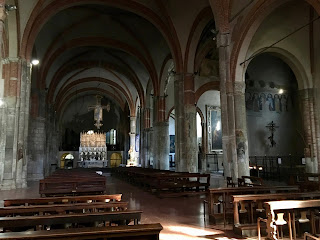Last day in Milan and we are hitting all the basic tourist spots. We plan to join a bus-tour later, so we explore the area northeast of the Piazza della Duomo in the morning. The Parrocchia di Santa Maria della Scala in San Fedele, by Pellegrino Tibaldi, sits a short walk north of the Duomo; it was started in 1579, just after San Sebastiano.
Part of the fun of reading Late Renaissance or Mannerist architecture is looking over the geometrical moves and trying to figure out what the designer had in mind. A clean floor plan can be found at the church's home page. Here we have two nearly-square, vaulted bays ending in a domed sanctuary, and then a semi-circular apse or choir beyond. The classical columns are layered, so there are pilasters marking the minor bays, single free-standing columns at the major bays holding the vaults, and then a bundle of pilasters framing the sanctuary.
The chapels are shallow arched spaces, with minor and major bays. The chapel arch keystones are set at the height of the pilasters, but without the capitals, creating a string course that shadows the metal ties in the arches above. The chapel arches spring from another band that essentially creates a minor order within the chapels.
These rhythms are also legible on the exterior. Oddly, the temple-front is not capped with a cross, and reads very clearly as a classical form, with an arched pediment over the main entry. As on the interior, the designer concentrates ornament in the bands and folds, while the surfaces are left quiet, catching and moving the light.
Just northwest from San Fedele, on the other side of the Teatro alla Scala opera house, is the Chiesa della San Giuseppe by Francesco Maria Richini, built from about 1607 to 1630. Plan and section can be found at this post. Here we find an inversion of expectation; we enter a domed space, the sanctuary is a nearly-square vaulted space, and the altarpiece is housed in a large archway beyond. The dome sits within an octagon, which sits within a square. The layering is also taken to an extreme, with thick pilaster bundles giving way to three-quarter round columns, and squared-off pilasters framing the sanctuary.
Set between the columns are small arched openings with balusters, which creates space in that gap and allows a reading of the enclosing square, but also tends to darken. The transition from round to square is echoed in the floor pattern (in plan) and on the exterior (in elevation), which displays the same eccentricities from the interior. The entry is marked by stacked temple-fronts, with an arched pediment enclosed in a triangular one at the top. There are far fewer quiet spaces here, maybe the ceilings, but all the creases and edges keep your eyes rolling about the forms, chasing the light.
With a bit of time before lunch, we stroll over to the Castello Sforzesco. And then a bit more wandering around, and we end up at the Palazzo Brera for a little sit-down break in the quiet courtyard.
In the afternoon we join our bus tour. We meet at the Duomo di Milano – Basilica cattedrale metropolitana di Santa Maria Nascente. The building is enormous, and absolutely coated with statues, creating a lacey light-grabbing surface: architecture that breaks down to sculpture as you get closer.
But the real stunner is the interior. The third largest catholic church behind the Vatican and the Cathedral in Seville, it is possibly the largest single space I've ever been in. Dark to the point of being dim; going from the bright afternoon sun and the marble exterior to this is a shock, and my eyes take quite a while to really adjust. Then we look up and see all the color from the seemingly never-ending stained glass panels.
The tour makes a couple of stops at the Galleria Vittorio Emanuele II and the Teatro alla Scala. Fun and imposing places to visit, but perhaps with a little less architectural merit.
The tour concludes with Leonardo da Vinci's The Last Supper, housed in the Chiesa de Santa Maria delle Grazie. Milan is the city of Leonardo, and this is the right way to end our visit here.
In many ways, what one sees is not the Last Supper as Leonardo painted, but a relic of that paining which only hints at the color, the imaginative use of perspective, and just the presence of that great image. Like at the Capella degli Scrovegni, entry is through a series of air locks into the old refectory room. The entry point provides the perfect view of the perspective (note how the cornice aligns to the painting), so the image becomes an extension of the room. The windows in the wall opposite are blocked to prevent UV exposure, but it's easy to see how the near wall in the painting is lit, the far wall is in shadow as if the light is coming from those windows; the figures in the scene are lit the same way.
Though I arrive knowing the Last Supper fills the wall at the end of a dining room, I am still impressed by the size. I am also shocked by the deteriorated state of this masterpiece; it's just a shadow of a painting, but the grandness and the importance of the work are still there.































